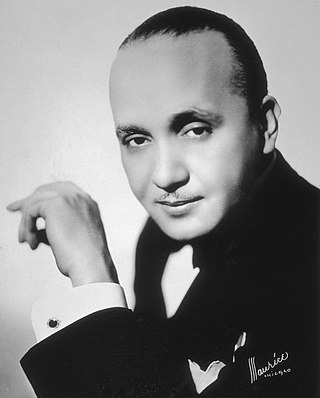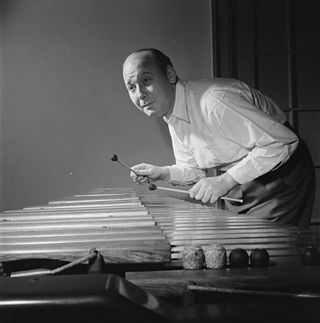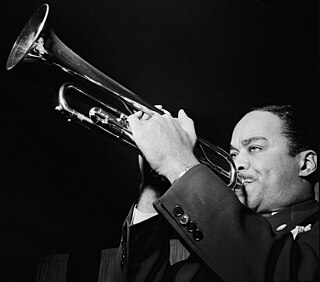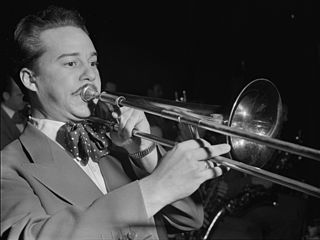Related Research Articles

Jimmie Noone was an American jazz clarinetist and bandleader. After beginning his career in New Orleans, he led Jimmie Noone's Apex Club Orchestra, a Chicago band that recorded for Vocalion and Decca. Classical composer Maurice Ravel acknowledged basing his Boléro on an improvisation by Noone. At the time of his death Noone was leading a quartet in Los Angeles and was part of an all-star band that was reviving interest in traditional New Orleans jazz in the 1940s.
Swing music is a style of jazz that developed in the United States during the late 1920s and early 1930s. It became nationally popular from the mid-1930s. Swing bands usually featured soloists who would improvise on the melody over the arrangement. The danceable swing style of big bands and bandleaders such as Benny Goodman was the dominant form of American popular music from 1935 to 1946, known as the swing era, when people were dancing the Lindy Hop. The verb "to swing" is also used as a term of praise for playing that has a strong groove or drive. Musicians of the swing era include Duke Ellington, Benny Goodman, Count Basie, Cab Calloway, Benny Carter, Jimmy Dorsey, Tommy Dorsey, Woody Herman, Earl Hines, Bunny Berigan, Harry James, Lionel Hampton, Glenn Miller, Artie Shaw, Jimmie Lunceford, and Django Reinhardt.

James Fletcher Hamilton Henderson was an American pianist, bandleader, arranger and composer, important in the development of big band jazz and swing music. He was one of the most prolific black musical arrangers and, along with Duke Ellington, is considered one of the most influential arrangers and bandleaders in jazz history. Henderson's influence was vast. He helped bridge the gap between the Dixieland and the swing eras. He was often known as "Smack" Henderson.

Carlos Wesley "Don" Byas was an American jazz tenor saxophonist, associated with swing and bebop. He played with Count Basie, Duke Ellington, Art Blakey, and Dizzy Gillespie, among others, and also led his own band. He lived in Europe for the last 26 years of his life.

Coleman Randolph Hawkins, nicknamed "Hawk" and sometimes "Bean", was an American jazz tenor saxophonist. One of the first prominent jazz musicians on his instrument, as Joachim E. Berendt explained: "there were some tenor players before him, but the instrument was not an acknowledged jazz horn". Hawkins biographer John Chilton described the prevalent styles of tenor saxophone solos prior to Hawkins as "mooing" and "rubbery belches". Hawkins denied being first and noted his contemporaries Happy Caldwell, Stump Evans, and Prince Robinson, although he was the first to tailor his method of improvisation to the saxophone rather than imitate the techniques of the clarinet. Hawkins' virtuosic, arpeggiated approach to improvisation, with his characteristic rich, emotional, and vibrato-laden tonal style, was the main influence on a generation of tenor players that included Chu Berry, Charlie Barnet, Tex Beneke, Ben Webster, Vido Musso, Herschel Evans, Buddy Tate, and Don Byas, and through them the later tenormen, Arnett Cobb, Illinois Jacquet, Flip Phillips, Ike Quebec, Al Sears, Paul Gonsalves, and Lucky Thompson. While Hawkins became known with swing music during the big band era, he had a role in the development of bebop in the 1940s.

Gaetano Alberto "Guy" Lombardo was a Canadian and American bandleader, violinist, and hydroplane racer whose unique "sweet jazz" style remained popular with audiences for nearly five decades.

James Melvin Lunceford was an American jazz alto saxophonist and bandleader in the swing era.

Lucius Venable "Lucky" Millinder was an American swing and rhythm-and-blues bandleader. Although he could not read or write music, did not play an instrument and rarely sang, his showmanship and musical taste made his bands successful. His group was said to have been the greatest big band to play rhythm and blues, and gave work to a number of musicians who later became influential at the dawn of the rock and roll era. He was inducted into the Alabama Jazz Hall of Fame in 1986.

Andrew Dewey Kirk was an American jazz bandleader and saxophonist who led the Twelve Clouds of Joy, a band popular during the swing era.

Red Norvo was an American musician, one of jazz's early vibraphonists, known as "Mr. Swing". He helped establish the xylophone, marimba, and vibraphone as jazz instruments. His recordings included "Dance of the Octopus", "Bughouse", "Knockin' on Wood", "Congo Blues", and "Hole in the Wall".

Wilbur Dorsey "Buck" Clayton was an American jazz trumpeter who was a member of Count Basie's orchestra. His principal influence was Louis Armstrong, first hearing the record "Confessin' that I Love You" as he passed by a shop window.

Bennie Green was an American jazz trombonist.
David Albert "Panama" Francis was an American swing jazz drummer who played on numerous hit recordings in the 1950s.

William C. "Buster" Bailey was an American jazz clarinetist.

Constance Foore "Connee" Boswell was an American vocalist born in Kansas City, Missouri, but raised in New Orleans, Louisiana. With sisters Martha and Helvetia "Vet", she performed in the 1920s and 1930s as the trio The Boswell Sisters. They started as instrumentalists but became a highly influential singing group via their recordings and film and television appearances.

Edward Joseph Bertolatus, also known as Eddie Bert, was an American jazz trombonist.

Taft Jordan was an American jazz trumpeter.
Henry Coker was an American jazz trombonist.
Charles Coleridge "Red" Richards was an American jazz pianist.

Richard Dominic Stabile was an American jazz saxophonist, clarinetist, and bandleader.
References
- 1 2 3 4 5 6 Colin Larkin, ed. (1992). The Guinness Who's Who of Jazz (First ed.). Guinness Publishing. pp. 350/1. ISBN 0-85112-580-8.
- ↑ [ dead link ]
- 1 2 Sleevenotes for Stompin' at the Savoy (1964) DECCA DL4444
- ↑ The Swing Era: The Development of Jazz 1930–1945, Gunther Schuller. New York: Oxford University Press, 1989. ISBN 0-19-504312-X